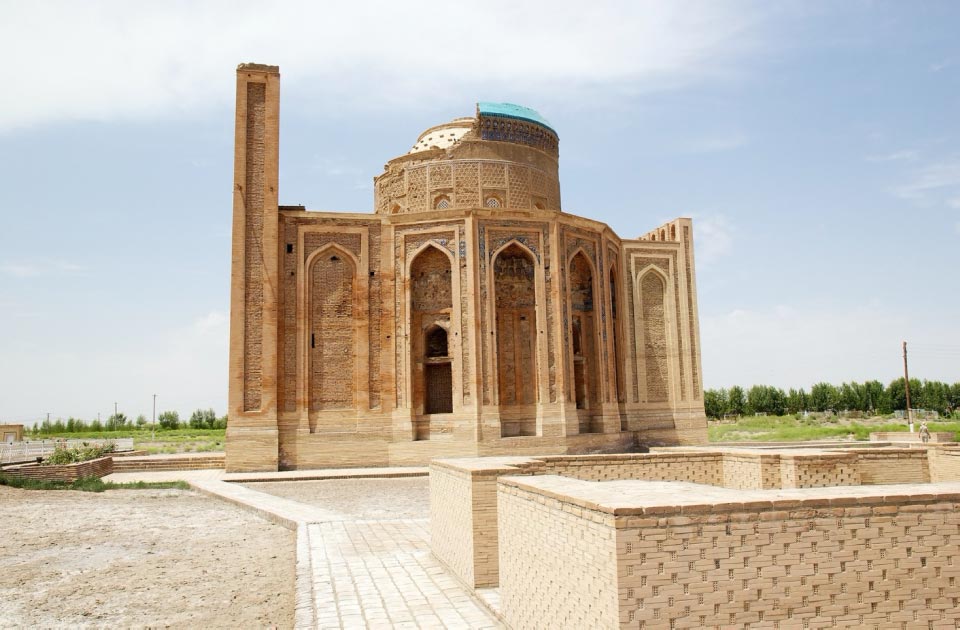Konye-Urgench, Protected After Genghis Khan’s Destruction
In an area of protected landscape of Turkmenistan lies an abandoned city that once played a critical role in the history of Central Asia. Situated on the Silk Road, Konye-Urgench was a wealthy city and contains well preserved monuments and buildings from the 11 th to the 15 th century. With its beautiful examples of Islamic architecture, it is one of Central Asia’s most important archaeological sites and a UNESCO World Heritage site.
The Rich History Of Konye-Urgench, Turkmenistan
Archaeologists believe that an urban settlement was first developed in the area sometime in the 4 th or 5 th century BC. The Achaemenid Persian Empire conquered much of Central Asia and Konye-Urgench, became a regional capital. Sadly, no monuments from this era remain.
Later the city was ruled by several empires, including, the Seleucid, Parthian, Sasanian, Arab, and Samanaid. Konye-Urgench reached its zenith between the 10 th and the 13 th century, especially under the Khwarezmian Empire.
Aside from prominence along the Silk Road which ran east to west, the city was also located on an important trade route running north to south and therefore prospered, second only in wealth and prestige to the famed city of Bukhara.
In the early 13 th century the Mongols attacked the Khwarezmian Empire and began a brutal campaign of conquest. Countless were killed by the mounted warriors of Genghis Khan in what is called ‘the bloodiest massacre in human history’. The Mongols besieged and destroyed Konye-Urgench and slaughtered its population. The nomads also destroyed the irrigation system in an orgy of destruction which forced the remaining citizens of Konye-Urgench to move the city to another location.
- Merv: In Ruins Today, How Does the Eternal City of the East Live on?
- Search to Find Tomb of Genghis Khan Picks up Pace
- Beni Hammad Fort: Ruins Attest the Dreams of a Medieval Algerian Islamic Dynasty

Statue of Genghis Khan with Legendary golden whip, Mongolia (mors74/ Adobe Stock)
This new city soon became wealthy under the rule of the Sufi Dynasty. However, another great conqueror, Timur the Lame (Tamerlane), attacked the city and it was once again destroyed. According to legend he left only one mosque standing.
Konye-Urgench once again rose from the ashes and under the Timurid Dynasty, but it never regained its former grandeur. When the course of the Amur River changed, the city went into irreversible decline. Khiva, to the south, became the regional capital and by 1600, Konye-Urgench was abandoned.
The Architectural Wonders Of Konye-Urgench
Despite the destruction wrought by the Mongols and Timur, there are still many impressive ruins in Konye-Urgench. The area is now a state historical and cultural park. To the east, in the city Kurgan, is a kyrk molla or mound, all that is left of a Persian fortress. Much of the city has been destroyed by conquerors and the climate.

The Kutlug-Timur Minaret flanked by two mausoleums (Maurizio/ Adobe Stock)
Of the many important buildings and monuments on this site, the most striking is the Kutlug-Timur Minaret. This dates from the 11 th century and was most likely built by a Khwazresmian Shah. It is 196 feet (60 m) tall and has a diameter of 12 feet (3.5 m). The decorative brickworks on the minaret bears many inscriptions in the Kufic style.
The Turabek Khanum Mausoleum is the burial place of a Khwaresmian queen, and it consists of a circular dome over a central hall that has a beautifully restored mosaic and remarkable tiling. The entrance to the tomb is through a massive arched gateway.
The Tekesh Mausoleum is the presumed tomb of the founder of the Khwarezmian Empire. The striking canonical roof is distinct and the hallway within has a dome enclosed by high walls. It was modelled on similar mausoleums built in Baghdad and was influential in the development of Islamic architecture in Central Asia.

Tekesh Mausoleum, Konye-Urgench (Maurizio/ Adobe Stock)
Among the fine buildings in the abandoned city is the mausoleum of Najm ad-Din al-Kubra, which holds the remains of the philosopher, chess master, and founder of the Kubrawiya Sufi order.
Many regard the Il Arslan Mausoleum as the most impressive monument that remains at Konye-Urgench. This cube-like structure, with a massive dome and decorated with tiles and mosaics, is entered via a large portal.
In the south-east section of the site is a medieval citadel that has walls up to 20 feet (6m) high and is made of mud brick.
Visiting Konye-Urgench in Turkmenistan
The historic site is located in the north of Turkmenistan and is not far from the border with Uzbekistan. The city of Dashoguz is located about 70 miles (112 km) away and it is possible to hire a car or take a train to the site. Guided tours are available.
Top image: Turabek Khanum Mausoleum, Turkmenistan Source: Maurizio/ Adobe Stock
By Ed Whelan
References
Baumer, C. (2016). The History of Central Asia: The Age of Islam and the Mongols. Bloomsbury Publishing.
Mayhew, B., Clammer, P., & Kohn, M. (2000). Central Asia (p. 576). Hawthorn, Victoria: Lonely Planet.
Available at: https://media.lonelyplanet.com/shop/pdfs/central-asia-6-contents.pdf
Mozafari, O., & Khosravi, A. (2018). Birthplace of Ismael Jorjani, A Renowned Iranian Physician: Jorjan (Near the Present-day Gonbad-e Kavus) or Urgench (The Present-day Uzbekistan). Jorjani Biomedicine Journal, 6(3), 72-73.
Available at: https://pdfs.semanticscholar.org/0cfb/2ff6044d9fcd39a8494fd17a7281adece51e.pdf



















